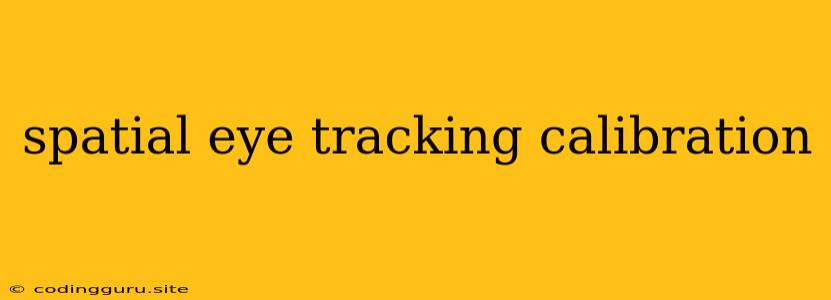Spatial Eye Tracking Calibration: Ensuring Accurate Gaze Tracking
Spatial eye tracking is a powerful technology that allows us to measure and understand human gaze. It has numerous applications in various fields, including human-computer interaction, virtual reality, marketing research, and healthcare. To ensure the accuracy of gaze tracking data, proper spatial eye tracking calibration is crucial.
What is Spatial Eye Tracking Calibration?
Spatial eye tracking calibration is the process of aligning the gaze data captured by an eye tracker with the real-world coordinates of the user's environment. This means mapping the eye tracker's gaze measurements to the actual position of objects in the user's field of view.
Imagine you're looking at a computer screen with an eye tracker attached. Without calibration, the eye tracker might incorrectly interpret your gaze direction, resulting in inaccuracies in data collection. Spatial eye tracking calibration corrects these inaccuracies by establishing a precise relationship between the eye tracker's measurements and the user's visual environment.
Why is Spatial Eye Tracking Calibration Important?
Spatial eye tracking calibration is essential for achieving accurate and reliable gaze tracking data. Here are some key reasons:
- Accurate Gaze Data: Calibration ensures that the eye tracker's gaze measurements accurately reflect the user's actual line of sight.
- Improved User Experience: Accurate gaze tracking enhances user interaction with devices and software, leading to a smoother and more intuitive experience.
- Reliable Research Results: In research settings, accurate gaze tracking is vital for obtaining reliable data and drawing valid conclusions.
- Enhanced Virtual Reality Experiences: Spatial eye tracking calibration is crucial for creating immersive VR experiences where accurate gaze tracking enables interaction with virtual objects and environments.
Types of Spatial Eye Tracking Calibration Techniques
Various techniques are employed for spatial eye tracking calibration. Some common methods include:
- Point-of-Gaze Calibration: This method involves the user looking at a series of fixed points displayed on a screen. The eye tracker records the user's gaze data at each point, allowing for calibration.
- Line-of-Sight Calibration: In this technique, the user fixates on a moving target, and the eye tracker records the gaze data over time. This allows for more precise calibration as it captures gaze direction across a range of movements.
- 3D Calibration: This method involves calibrating the eye tracker in a three-dimensional space. This is particularly useful for applications requiring precise gaze tracking in VR or augmented reality environments.
Tips for Successful Spatial Eye Tracking Calibration
To achieve accurate spatial eye tracking calibration, consider the following tips:
- Use a Controlled Environment: Ensure a stable and well-lit environment for calibration. Avoid distractions and potential interruptions.
- Follow Calibration Instructions: Adhere to the specific instructions provided by the eye tracker manufacturer or software.
- Maintain a Steady Head Position: Keep your head still during calibration to avoid inaccuracies.
- Calibrate Frequently: It is advisable to calibrate the eye tracker regularly, especially if environmental conditions change or the user's position shifts.
Examples of Spatial Eye Tracking Calibration in Action
Spatial eye tracking calibration is used extensively in various fields. Here are some examples:
- Marketing Research: Eye tracking data collected through spatial eye tracking calibration helps researchers understand consumer behavior, such as product preferences and website navigation patterns.
- Healthcare: Eye tracking is used for diagnosis and treatment in conditions such as autism spectrum disorder, attention deficit hyperactivity disorder (ADHD), and neurological disorders.
- Virtual Reality: Spatial eye tracking calibration is crucial for creating immersive VR experiences where users can interact with virtual objects and environments using their gaze.
Conclusion
Spatial eye tracking calibration is an essential aspect of gaze tracking technology, ensuring accurate data collection and reliable results. By understanding the different calibration techniques and following best practices, users can obtain precise gaze tracking data that unlocks a wide range of applications in various fields.
